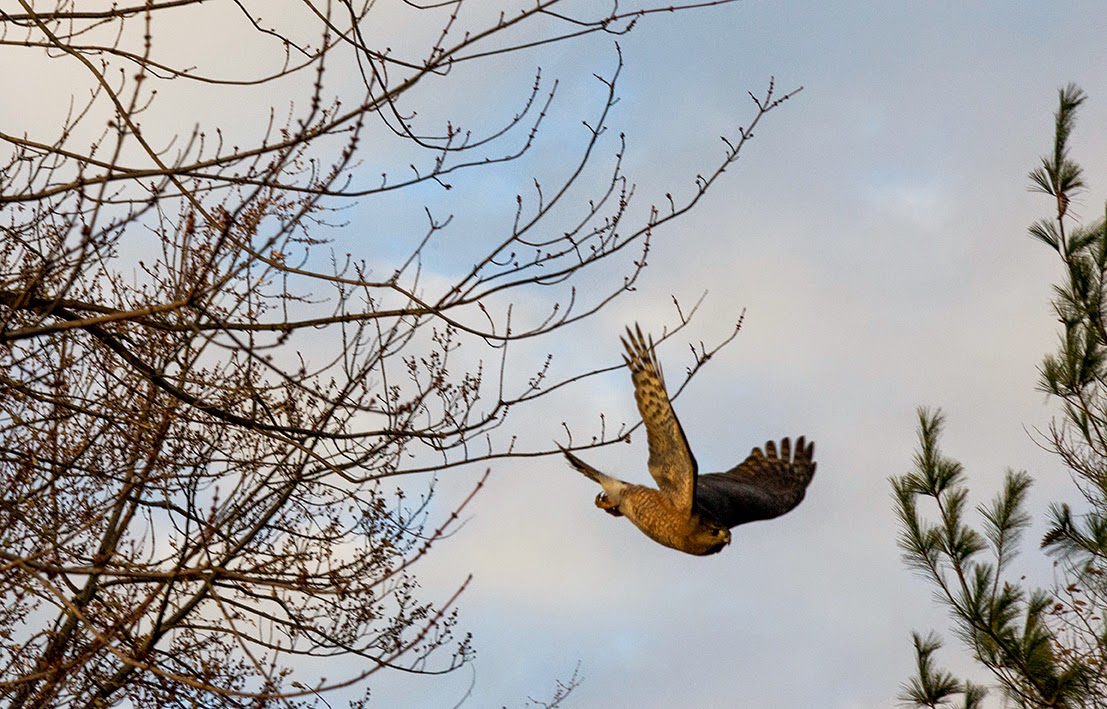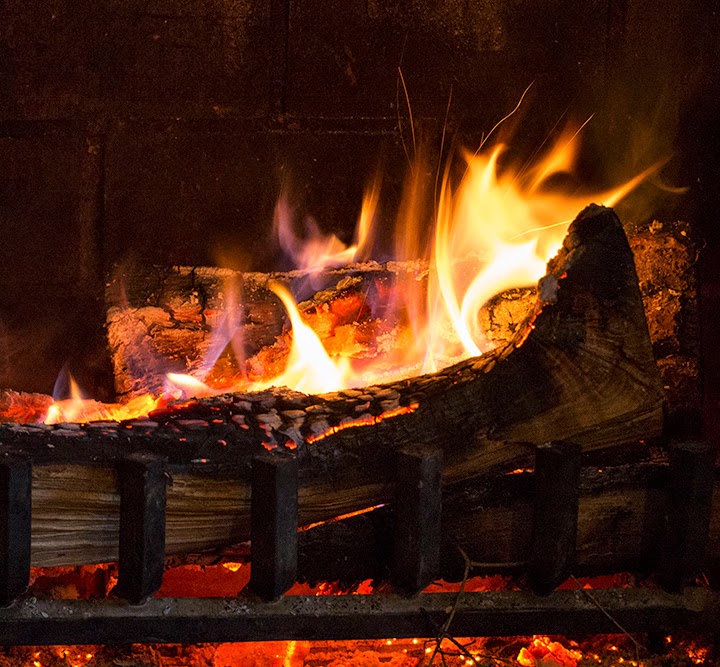Ferida Wolff's Backyard: Cozy Indoors, A Hawk in Suburbia & The Woodpeckers Return
Cozy in Our Indoor Backyard
This past week has been cold and often rainy so I decided to enjoy our backyard inside. We stacked firewood from a two-year-old cord (now nicely weathered) in the fireplace in our den then added branches that had fallen onto the lawn during the windy Fall days for kindling. The logs were lit and blazed with delicious warmth. The scene cozied up the den. We planted ourselves on the sofas and read books in the light and warmth of the flames.
Ahhh.
We tend to make fewer fires than most people who have fireplaces which means that the leftover wood in the cord is nice and dry for the next season/s. We discovered how wet wood can be really smoky so we appreciate letting the wood age.
But what about the environmental cost of having a fireplace? Well, there is a cost but that impact depends on the type of fireplace, the kind of wood, even the kind of fuel. Whether a tree is burned or dies it oxidizes, just at a different rate. Trees are a renewable resource — we can replace them. Reputable wood harvesters know how to actively manage their wood lots.
I admit I like my fireplace. I also confess that I am concerned about its consequences. Isn't that like so much of life? We make choices and hope they aren’t harmful as they support us in how we choose to live.
What kind of wood is good for the fireplace?
Pros and cons of different kinds of fireplaces:
And what about the environment?
http://www.alternativeenergyprimer.com/Environmental-effects-of-wood-burning.html

I am used to seeing hawks off in the distance, wings spread, floating on the air currents beyond the height of our neighborhood trees. There is a grace to their flying, so smooth that it almost seems they aren’t flying at all.
Occasionally a hawk will come closer, just above our backyard trees. No doubt it is scoping out the movements on our bird feeders. Most of the time the birds are savvy and disappear when the hawk is around, though not always. I have found splashes of feathers on the lawn, usually from a mourning dove that didn’t move off fast enough. And we have enough squirrels and chipmunks to satisfy the hungriest hawk.
This week I was surprised, however, to find a hawk right in our backyard, sitting in the maple tree near our patio. It wasn’t the kind of place I would expect a hawk to be. It was high for people but not typical hawk height. And it was close to an inhabited site. The bird sat on a lower branch, another unusual activity. It seemed to be aware of every move we made near our back storm door but it wasn’t inclined to leave. Eventually, it took off across our yard to places unknown.
I admit I was shaken. It is one thing to see such a creature in the distance and quite another to have it within whistling distance, which I couldn’t help doing. Was it getting used to us? Not necessarily a good thing. Our living needs are obviously different. Can we live together in peace? As people take up more land space from the natural inhabitants the question becomes urgent. I hope we can do a better job of co-existing with the hawks than we often do with people who have divergent lifestyles.
A common bird in America:
http://animals.nationalgeographic.com/animals/birds/red-tailed-hawk/
http://www.livestream.com/cornellhawks:
Cornell Lab of Ornithology's All About Birds website

The Woodpeckers Return
The woodpeckers found us again this year. It's a treat to see them. We have a male and female munching on the black oil sunflower seeds. They are a nice size and lovely to look at.
I used to think that all woodpeckers only came in the Woody Woodpecker persona but that was incorrect; woodpeckers come in lots of variations. I believe our kind is a Northern Flicker. I know that dedicated birdwatchers need to identify what birds they see but I am not obsessed with identification. It’s the visual aspect of bird watching that gets me. I don’t have a life list of birds, either, documenting the birds I see in my travels though I have been privileged to see many different kinds. A birder likes to observe birds in their natural habitats. My backyard may not qualify as natural because when I put out seed for the birds, it automatically changes the environment. I say that the birds will find food wherever it is so why not in our backyard? I’m pretty accepting of whichever birds show up.
I’m sort of like that with people, too. I am always impressed with how much variety there is in humanity. It’s amazing to think that the category of person can come in so many sizes, colors, shapes, and individual details. Like the birds, each person has his or her own characteristics and personality. Pretty remarkable, I say, whether bird or person. And inspiring, too, that our world can support so much diversity, as long as we value it.
Lots of woodpeckers have red heads:
The Committee on the Status of Endangered Wildlife in Canada (COSEWIC) assessed this species as threatened in 2007, and Ontario has listed it as a species of special concern for the past dozen years.
©2014 Ferida Wolff for SeniorWomen.com
Relationships and Going Places, Home and Shopping, Health and Science, Home, Garden, Senior Women Web, Articles, Sightings, Ferida Wolff, Authors, What's New









